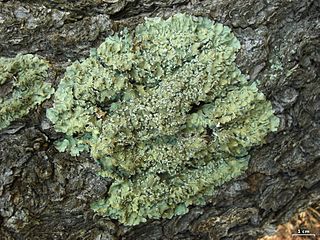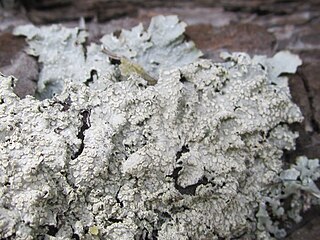
Flavopunctelia is a genus of foliose lichens in the family Parmeliaceae. The genus contains species that are widespread in temperate and tropical areas. The genus is characterised by broad, yellow-green lobes, point-like (punctiform) pseudocyphellae on the thallus surface, and bifusiform conidia. All species contain usnic acid as a major secondary chemical in the cortex. Flavopunctelia was originally conceived as a subgenus of Punctelia by Hildur Krog in 1982; Mason Hale promoted it to generic status in 1984.

Flavoparmelia is a genus of foliose lichens in the family Parmeliaceae. Because of their appearance, they are commonly known as greenshield lichens. The widely distributed genus contains 32 species. It was circumscribed by American lichenologist Mason Hale in 1986 to contain 17 former Pseudoparmelia species with broad lobes, usnic acid in the cortex, and isolichenan in the cell walls.

Punctelia is a genus of foliose lichens belonging to the large family Parmeliaceae. The genus, which contains about 50 species, was segregated from genus Parmelia in 1982. Characteristics that define Punctelia include the presence of hook-like to thread-like conidia, simple rhizines, and point-like pseudocyphellae. It is this last feature that is alluded to in the vernacular names speckled shield lichens or speckleback lichens.
Hypotrachyna vainioi is a species of foliose lichen in the family Parmeliaceae. It is found in Brazil.
Punctelia transtasmanica is a species of foliose lichen in the family Parmeliaceae. It is found in Australasia.
Punctelia nashii is a species of foliose lichen in the family Parmeliaceae. It is known only from California.
Punctelia crispa is a species of foliose lichen in the family Parmeliaceae. Found in Brazil, it was described as a new species in 2009 by lichenologists Marcello Marcelli, Patrícia Jungbluth, and John Alan Elix. The holotype specimen was collected in the Botujuru quarter of Campo Limpo Paulista municipality in São Paulo State. There it was found in a transition zone between a mesophyllous forest and a cerrado forest, growing on a tree trunk. It has a greyish thallus loosely attached to its substrate, measuring up to 10 cm (4 in) in diameter. Soredia on the thallus surface have a coarse texture, and are dense so that it gives areas near the thallus centre a "crispate" appearance, a feature for which the species is named. The medulla is white, while the lower surface of the thallus is pale brown, becoming darker near the centre. The lichen contains atranorin as a minor substance, gyrophoric acid as a major substance, and trace amounts of lecanoric acid.
Punctelia imbricata is a species of foliose lichen in the family Parmeliaceae. Found in Brazil, it was described as a new species in 2009 by lichenologists Marcello Marcelli, Patrícia Jungbluth, and John Alan Elix. The holotype was collected in the Paulista municipality of São Paulo State. There it was found growing on the trunk of a mango tree, which was in a shaded and humid location in an orchard. The lichen has a greenish-grey thallus measuring 15–20 cm (6–8 in) wide, with a smooth upper surface that becomes a bit wrinkled in age; the lower surface is black. Punctelia imbricata contains trace amounts of atranorin and lecanoric acid, minor amounts of orcinyl lecanorate, and gyrophoric acid as the major secondary metabolite in the medulla. The specific epithet imbricata refers to the "imbricate" lobules.
Punctelia roseola is a species of foliose lichen in the family Parmeliaceae. Found in Brazil, it was described as a new species in 2009 by lichenologists Patrícia Jungbluth, Marcello Marcelli, and John Alan Elix. The specific epithet refers to the pale rose colour of the medulla. The holotype was collected from Jurumirim municipality in São Paulo State, close to the Tietê River. There it was found growing on an isolated tree in a dry pasture, without direct sunlight. It has a grey thallus measuring 10–20 cm (4–8 in) wide; the lower thallus surface is pale, becoming darker near the centre. The lichen contains atranorin, lecanoric acid, and several butlerins as minor compounds, butlerlin D as a somewhat major compound, and gyrophoric acid as the major secondary metabolite in the medulla.
Punctelia negata is a little-known species of foliose lichen in the family Parmeliaceae. It is found in South America.
Punctelia subalbicans is a species of foliose lichen in the family Parmeliaceae. It is found in Australia and New Zealand, where it grows on the bark of various tree species.
Punctelia subpraesignis is a species of foliose lichen in the family Parmeliaceae. It occurs in Mexico, South America, and East Africa, where it grows on bark and on rocks. Major characteristics of the lichen that distinguish it from other Punctelia species include the C+ and KC+ rose spot tests of the medulla, ascospores that are smaller than 20 μm, and unciform (hooklike) conidia.
Punctelia cedrosensis is a species of foliose lichen in the family Parmeliaceae. It is endemic to Mexico, where it grows on the bark of conifers.

Punctelia punctilla is a species of foliose lichen in the family Parmeliaceae. It is found in Africa, South America, and North America, where it grows on bark and on rocks. The main characteristics that distinguish Punctelia punctilla from other species of Punctelia are the presence of isidia on the thallus surface, a pale brown thallus undersurface, and the presence of lecanoric acid in the medulla.
Punctelia novozelandica is a species of foliose lichen in the family Parmeliaceae. Found in New Zealand, it was formally described as a new species in 1988 by John Alan Elix and Jen Johnston. The type specimen was collected in Port Hills, Banks Peninsula (Canterbury), where it was found growing on moist rock ledges in a remnant forest. The lichen grows on both rocks and tree bark in cool temperate podocarp forests on both islands of New Zealand. It is quite similar in appearance to Punctelia subflava, but is distinguished from that species by the black thallus undersurface.

Punctelia perreticulata is a widely distributed species of foliose lichen in the family Parmeliaceae. It occurs in Mediterranean Europe and Russia, North America, South America, Australia, and New Zealand, where it grows on rocks, bark, or wood. Its main distinguishing features are its thallus surface, marked with many shallow depressions, grooves, or pits, and sorediate pseudocyphellae. The lower side of the thallus is ivory to tan towards the centre and the major secondary metabolite in the medulla is lecanoric acid. A lookalike species with which it has been historically confused is Punctelia subrudecta; this lichen can be distinguished from Punctelia perreticulata by the texture of the thallus surface, or, more reliably, by the length of its conidia.
Punctelia diffractaica is a species of foliose lichen in the family Parmeliaceae. It is found in Peru.
Punctelia subflava is a species of foliose lichen in the family Parmeliaceae that occurs in Australia.

Punctelia borreri is a species of foliose lichen in the family Parmeliaceae. It is a common and widely distributed species, occurring in tropical, subtropical, and temperate regions of Africa, Asia, Europe, North America, Oceania, and South America. The lichen typically grows on bark of deciduous trees, and less commonly on rock. Some European countries have reported increases in the geographic range or regional frequency of the lichen in recent decades, attributed alternatively to a reduction of atmospheric sulphur dioxide levels or an increase in temperatures resulting from climate change.
Parmelia protosignifera is a species of foliose lichen in the large family Parmeliaceae. Found in Australia, it was described as a new species in 1988 by lichenologists John Elix and Jen Johnston. The type specimen was collected on sheltered granite ledges in Eucalyptus woodland on the eastern slopes on Tinderry Peak in New South Wales. It has also been collected in Victoria, as well as South Island and Stewart Island of New Zealand.




